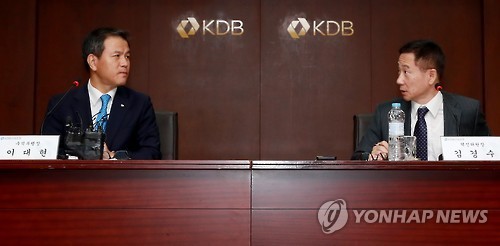South Korea’s state-run financiers on Monday released plans to become slimmer and financially healthier in line with ongoing restructuring activities in the country’s major industries.
Korea Development Bank, the main creditor of 132 local businesses, came up with a package of self-correcting measures, including enhancing its fiscal soundness, cutting employee wages and downsizing executive levels. Such measures have come in response to growing public criticism leveled at the bank over its failed management of its affiliated firms, such as the bankrupt Hanjin Shipping and troubled Hyundai Merchant Marine.
 |
Kim Kyung-soo (right, professor at Sungkyunkwan University, and Lee Dae-hyun, senior vice president of Korea Development Bank, talk after announcing measures to improve the state-run bank's operations at its headquarters in Yeouido, western Seoul, Monday. |
KDB’s “innovation committee,” led by Kim Kyung-soo, an economics professor at Sungkyunkwan University, and other outside experts, came up with measures for the bank to overhaul its operations and regain public trust as the country’s largest public financier.
“Absence of systematic management of affiliated companies, lack of expertise on corporate restructuring and seniority-based, rigid personnel system are pointed out as the current problems of the KDB,” Kim said at a press conference held at the KDB headquarters in Yeouido, western Seoul. The bank will slash up to 40 billion won ($35 million) in operational costs by 2021 and reduce its workforce by 10 percent from the current 3,193 employees to 2,874. The cost reduction will include wage cuts totaling 35.1 billion won and trimming bank branches worth some 4.9 billion won.
KDB will also complete sell-offs of 95 of 132 subsidiaries by the end of the year, complying with the principle of selling price being set by the market. So far, the bank has finished sales of 11 affiliates, including KDB Daewoo Securities.
To improve its fiscal soundness, the bank will minimize the use of the government’s 11 trillion won recapitalization fund only for emergency corporate restructuring, the committee said.
“The bank will finance mainly from selling the assets and issuing contingent convertible bonds,” Kim said.
KDB has so far recouped 4.1 trillion won by selling a securities brokerage to Mirae Asset Securities and issuing 1 trillion won in contingent convertible bonds. The committee said the bank will be able to finance another 3 trillion won next year by selling Daewoo Engineering & Construction.
The same day, the Export-Import Bank of Korea also announced plans to tighten management of financial risks and downsize its workforce.
The financier will toughen screening credits of importers and exporters, while capping the maximum amount of lendable loans at 40 percent of an individual borrower’s capital and 50 percent of a corporate borrower’s, down from the current 60 percent and 80 percent respectively.
Korea EXIM Bank will cut its budget for next year by 3 percent, while reducing manager-level employees by 10 percent from the current 190 and closing three overseas offices, from 25 to 22, by 2020.
The number of vice presidents will also be slashed from the current 10 to two in order to cut costs. The bank’s domestic branches and offices will be reduced 30 percent from 13 to nine by 2018.
Both KDB and EXIM Bank included a strict ban on “parachute appointments” of the banks’ retired executives as heads of affiliated or related businesses or institutions as part of self-improvement plans, which have been criticized as a cause of lax management and moral hazards in the public financing sector.
By Song Su-hyun (
song@heraldcorp.com)
Cation: Kim Kyung-soo (right), professor at Sungkyunkwan University, and Lee Dae-hyun, senior vice president of Korea Development Bank, talk after announcing measures to improve the state-run bank’s operations at its headquarters in Yeouido, western Seoul, Monday. Yonhap








